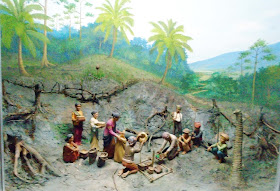Part 3:
In celebration of International Museum Day May 18 2022:
Dioramas Depicting the Philippine Grains
Industry at NFA Grains Museum
A diorama is a three-dimensional scene of an event or subject with a theme presented stage-like, complete with backdrop, props and virtual reality effects. The scene is usually built behind glass for protection and environment control.
Dr Abe V Rotor
.Living with Nature - School on Blog (avrotor.blogspot.com)
Also open Naturalism -the Eighth Sense
Masagana 99 Diorama
The flagship of the Marcos administration, Masagana 99, a nationwide rice production program made the Philippines a net exporter of rice in the later part of the seventies. Prominent characters behind the program are shown in the diorama led by President Ferdinand Marcos, First Lady Imelda Marcos, Agriculture Secretary Arturo Tanco, and NFA (then NGA) Administrator Jesus Tanchanco. Witnessing the launching ceremony are cabinet secretaries and guests.Banaue Rice Terraces Diorama
The Rice Terraces in Banaue in the Cordillera region has been declared World Heritage site by UNESCO in 1995. There are terraces believed to be as old as the Pyramids of Egypt, and much older than the Great Wall of China. Science is still studying the sustainability of these terraces not only in terms of productivity, but as as engineering masterpiece for which the Banaue Rice Terraces is dubbed "the 8th wonder of the ancient world." Encomienda System Diorama
The Encomienda System dominated agriculture during Spanish rule over the islands for more than three centuries. The encomienderos were the friars and Spanish officials who are similar to hacienderos. Although the system underwent land reform, it still persists to this day under corporate umbrella such as the case of Del Monte pineapple plantation. Hacienda Luisita in Tarlac still retains some features of the system.Yakan Rice Culture Diorama
Rainfed (sahod ulan) farming dominates the uplands and hillsides. Good harvest depends on generous amount and distribution of rainfall during the monsoon. Since ancient times festivities were made to implore providence for bountiful harvest as shown in this diorama. Harvest festivals were likewise offered as thanksgiving. This practice still exists especially among the minorities like the Yakans of Mindanao.Harvest Time Diorama
Harvest time in the Philippines marks the end of habagat or monsoon and the start of amihan or Siberian High when cold wind from the north nurtures the ripening of grains turning whole ricefields into rich golden color. Soon haystacks or mandala rise like mushrooms dotting the harvested fields. Children fly kites in the open field, a memorable experience of childhood on the farm. Rustic scenes at harvest time have been captured on canvas by Filipino artists led by national artist Fernando Amorsolo. Margate System of Rice Planting Diorama
The system significantly increased rice yield in the fifties and sixties through a methodical approach, like straight line and equidistant spacing of seedlings, and thorough land preparation. The system retained the quaintness of farm life like a housewife bringing food to the planters, and neighbors lending a hand in the spirit of bayanihan or cooperation. Its basic features have been adopted by the Masagana 99 program in the seventies.





















No comments:
Post a Comment